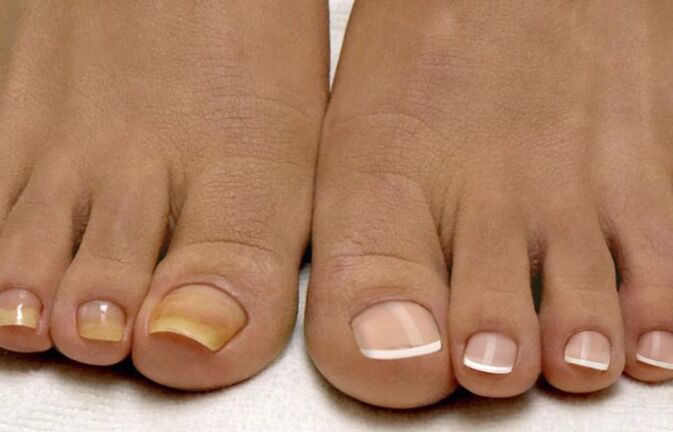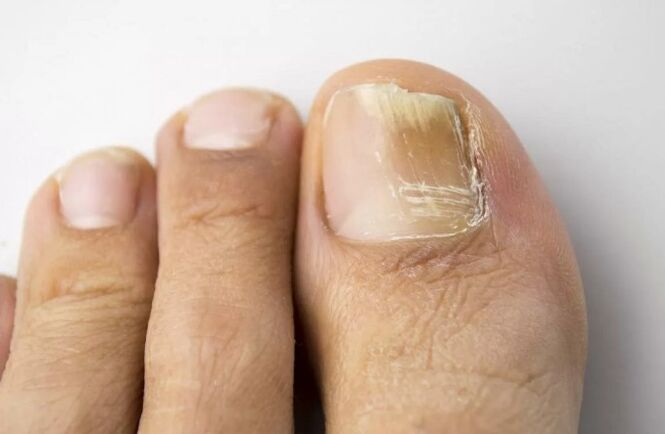The fungus of nails and skin on the legs is a very popular phenomenon in modern society. The negative main feature is the fact that this disease is subject to frequent relapses. Medicines against these subspecies of fungal diseases are widespread on the pharmaceutical market, but a responsible approach to recovery is one of the main factors for the fight against the disease. We will warn that the treatment is almost identical to the treatment of mushrooms on the hands.

Symptoms of nail fungus
Despite the fact that this type of fungal diseases are most often referred to as mushrooms by nails on the legs, it must be taken into account that not only nail plates, but also surrounding skin suffer from harmful fungal spores. The main features of the mushroom on the legs are:
- Reddening in the interdigital zone, the gradual appearance of the peeling;
- The appearance of itching, initially barely noticeable, but that becomes stronger when the disease is progressive;
- Sometimes bubbles occur with liquid on the skin;
- In the later stages - the appearance of painful cracks;
- Nail formation. Depending on the type of mushroom, it can have a different nature. So distinguish:
- Hypertrophic type of deformation. An increase in the thickness of the nail, but at the same time an increase in the fragility of the plate. The nail hurts and crumbles with physical exposure.
- Normoprophic type of deformation. The thickness of the nail does not change, but it captures a pronounced shiny color, horizontal yellow stripes also occur.
- Atrophic type of deformation. The nail plate becomes thin and dull. Colors and strips of a white shadow appear on the nail, they grow and merge in the future.
Diagnosis of mycosis of the legs at home
If you suspect the occurrence of symptoms of mushrooms on the legs, it is best to contact a specialist, since only the doctor is able to correctly determine the belonging of a fungal disease and to prescribe the most effective treatment. However, if you don't have time to go to the hospital, you can confirm or refute the fears at home. To do this, it is necessary to dilute the potassium perpetrator (potassium perpetrator) until a light volunteer shadow in water temperature water is recorded. Then lower the toes into the solution and hold for a few minutes. You will see that a healthy nail captures a slightly brownish color. While the mushroom affected by the mushroom remains the same color.

Preparation for the treatment
This object takes on an important place in the entire treatment of the skin of the skin and nails on the legs. The following personal hygiene rules are required before each treatment session:
- The removal of the affected part of the nail plate with manicure scissors or one -way sessions. The procedure should be repeated daily until recovery. Carefully disinfect the tool used immediately after the procedure.
- Daily disinfectants for legs with soda or soap also contribute to the disappearance of bacteria and accelerated treatment. If you use local therapy medication, it is best to make such baths shortly before using the drug.
- A good additional means of preparing the nail for treatment is tea tree oil. It is recommended to apply a drop of oil under the nail plate and lubricate the surface with another.
- Compliance with the general rules for hygiene and preventive measures to prevent nail fungi on the legs.
Treatment of nail fungus
There are many medication to treat the foot mushroom.
- The main category includes local medication: antifungal lacquer, ointments and creams. This is generally used by medication that are sold without a doctor's bond. The treatment usually takes one to three weeks. It should be taken into account that treatment with local spectrum medication must be taken into account strictly according to the instructions, otherwise the effect of the use can decrease.
- Second place in popularity is used by systemic medicines or in other words a variety of capsules and tablets. The treatment of the foot fungus with this category of medication is usually after preliminary advice with a doctor, since in some cases there are contraindications for their use. In addition, system medication is often supplemented by treatment with local therapy media.
- The treatment of mycosis of the legs is also carried out today with a laser. This procedure only gains popularity in our country, but has a number of certain advantages, including: the minimum risk of relapse, mild and painless treatment.
- A slightly less popular method to get rid of the mushroom on your fingers is the hardware pedicure. This treatment method mostly takes place in combination with systemic drugs. It is used more often for advanced stages of the disease.
- After all, the last way to get rid of the nail fungus is an operation. Today this is a small FED treatment method, since the process is quite painful and has a long rehabilitation phase.

Treatment of mushrooms on the legs with folk remedies
Treatment with folk methods is also coordinated with the treatment of mushrooms on the legs. In most cases, doctors recommend combining folk medication with proven pharmaceutical drugs. The following are among the most popular referendums:
- Treatment with propolis. Dive a cotton smear in a 20% alcohol solution from Propolis and apply to an infected nail plate for 15 minutes, the treatment takes three weeks. A side effect is the itching when using the application.
- Garlic treatment. Mix two pre -packed cloves with one hundred grams of butter and leave the resulting porridge 24 hours. Then apply the mixture to areas of the legs that are affected by the skin fungus for a month.
- Treatment of oak bark. The treatment of the mushroom between the toes in this way takes about a month. The recipe for the solution: 5 tablespoons of oak bark are loosened in one liter of cooked water after the water is to be reproduced, and 10 grams of drug killers are added at the same time. The infusion is most effective within two hours after cooking.
- Treatment with chamomile fees, cord and violet. Each collection at the same proportions (approximately one tablespoon) is poured into a liter of boiling water that exists for two hours. Rinse your legs in the solution before going to bed to recovery.
- Scroll treatment with Rowan. Apply crushed Rowan leaves to the affected areas for ten days and hold about half an hour. You can repair the mixture with clean socks.
- Treatment of the golden culing plant. The soft leaf of the plant is applied to the sick nail plate at night. It is better to connect or remedy it in a different way.
- Treatment of Aspen bark. As with a recipe from the oak bark, the shredded bark is poured with cooked water (it is better to take 500 grams of water). Treatment can be supplemented with a mixture of soda and laundry.
- Treatment with tea mushroom. This product can be used in two variations: like a dry mix and solution. The first method: the chopped tea mushroom grinds into the patient for about two weeks (first the fungus must be cleaned from the film). The second method: Pour 2 teaspoons of the mushroom with 200 grams of vodka and put it in a cool dark place for 10 days. The solution can be used for the whole night, while the damped cotton smear is attached with cellophane or clean socks.
- Treatment with potatoes. Potato remains after dinner are a completely effective drug against the mycosis of the legs. Cooking recipe: The potato cleaning must be cooked in a soft condition, then drain the water in the pool and the infected feet rise in it. After the park, apply the remaining porridge to the nail plates and then rinse off with warm water.
- Apple vinegar treatment. Dissolve 1 cup of salt in water and then add several cloves to garlic and half a glass of apple cider vinegar. This infusion can be solved in several liters of warm water and used daily as a steam bath for the legs. It is used before recovery.
- Iodine treatment. The hardening of the mushroom on the legs with iodine is quite simple: lubricating the damaged nail with tincture every day. Painful sensations can occur about 4-5 days of treatment, but they don't last long.
- Treatment with salt baths. A tablespoon of sea salt is dissolved in one liter of warm water. In this warm bath, the affected feet rise for two weeks.


























